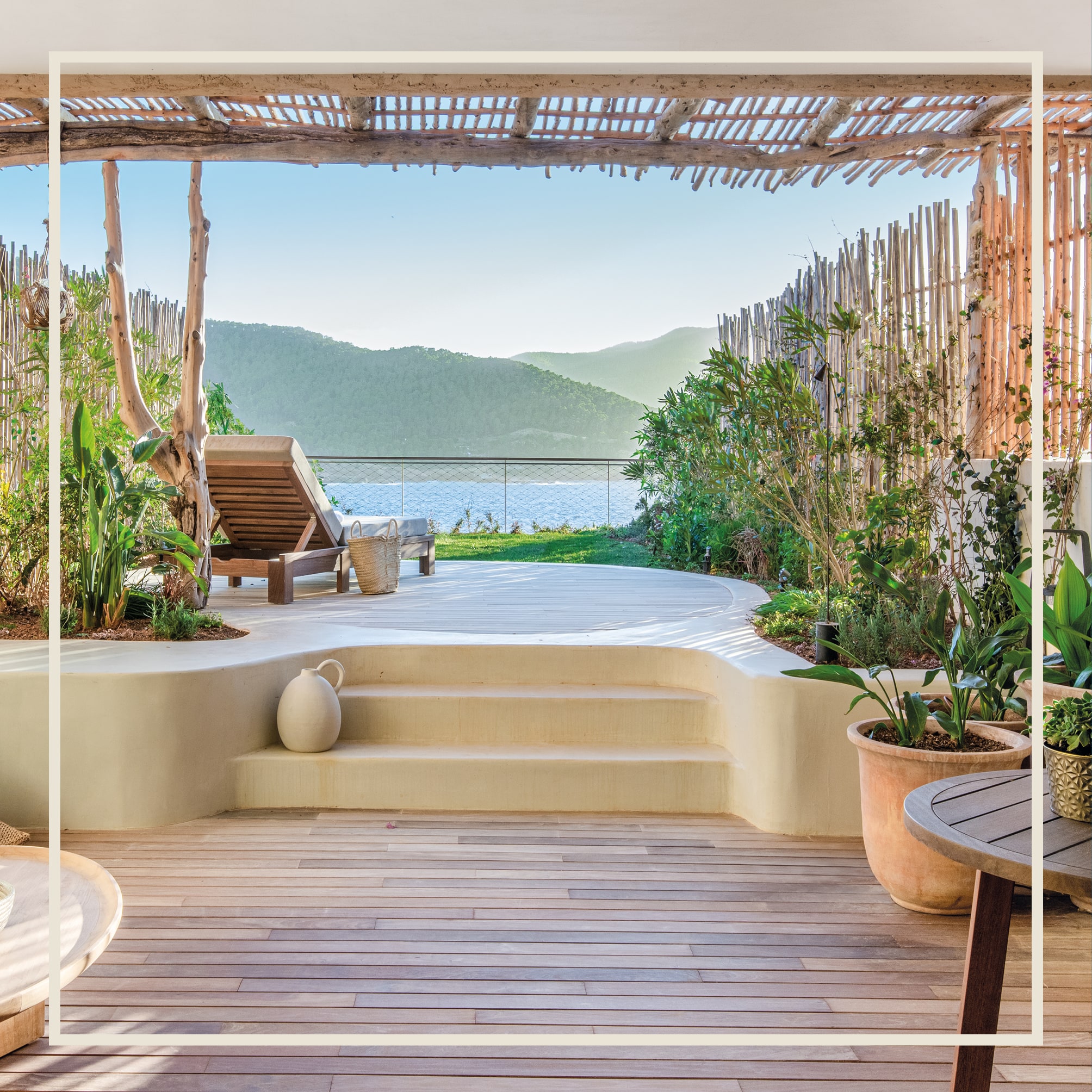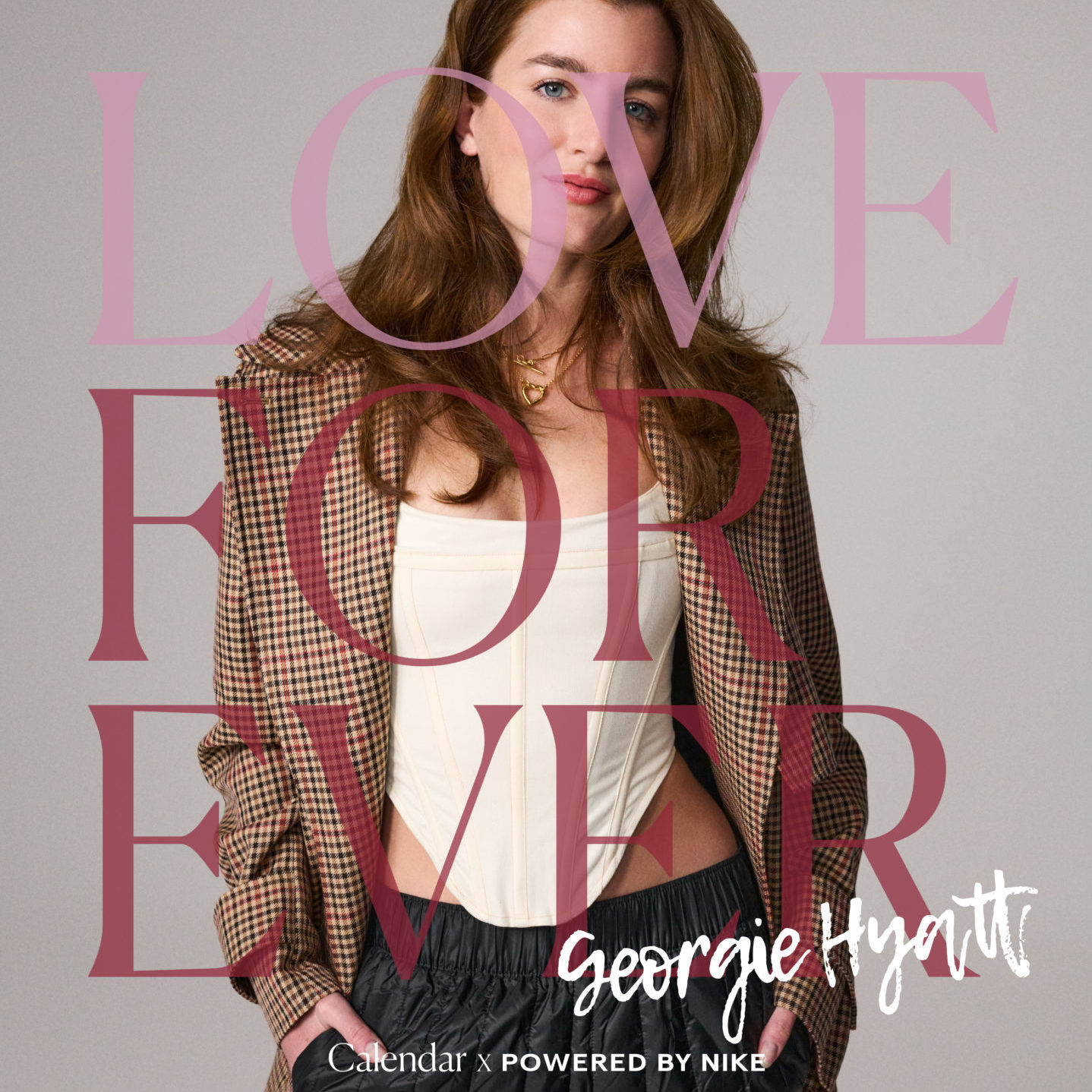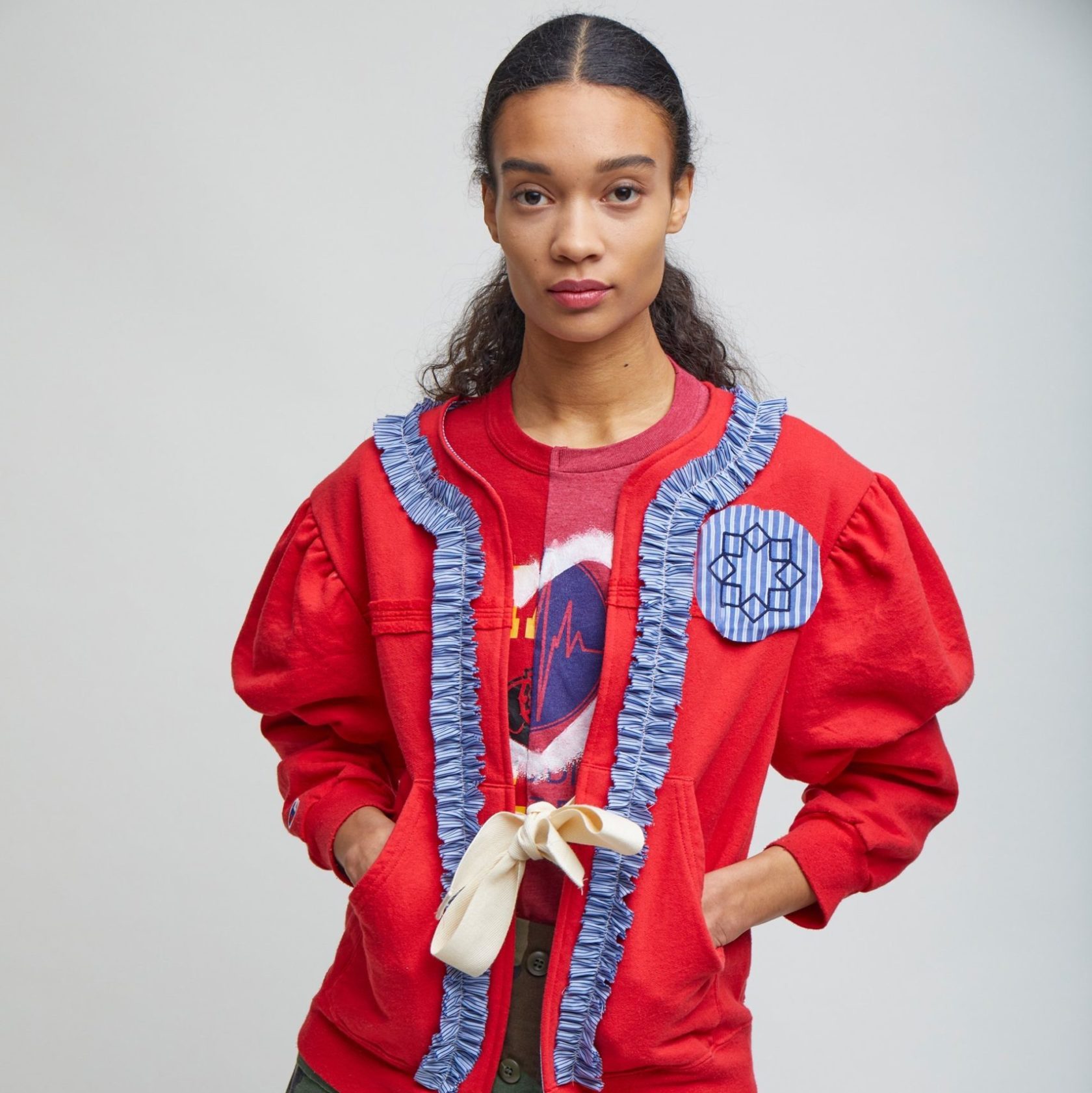The Calendar Profile
Anya Hindmarch and the farm-to-wardrobe revolution
For her latest trick, the fashion game-changer has created an ingenious - and deeply covetable - bag collection that can decompose back to earth. Sarah Bailey caught up with the unstoppable accessories queen about what scares her, COP26 and how Arizona Muse inspired her
Sarah BaileyThe future, according to Anya Hindmarch – relentlessly creative businesswoman with wit and queen of the British handbag – is all about farming. “It’s about our ability to provide, but also our soil health, the health of our land and crops. We’ve seen the tech boom; I think the next boom is going to be farming. And female farmers are going to be the coolest thing.”
It’s late-ish on a Friday afternoon and Hindmarch, who’s chatting to me via Zoom (dressed in a vintage Dries Van Noten duster coat, with a newly cut blunt fringe just brushing the top of her specs), is still at the office putting the final touches to her latest game-changing project ‘Return To Nature’, a capsule collection of biodegradable handbags, inspired by one exceptionally cool female farmer: Arizona Muse, the model and founder of soil-health charity DIRT (who relocated to Ibiza earlier this year with her young family to practice regenerative agriculture there).
The health of our soil is at the heart of Hindmarch’s ‘Return To Nature’ collection, which has been designed to be capable of degrading naturally – from earth, to cow, to bag, to earth and on again in a model of perfect circularity. The capsule consists of three styles: a bucket bag, a tote (in two sizes), and a cross-body bag – available in rich shades of tan and chocolate leather. There is no hardware, there are no linings (which renders the aesthetic all very French Vogue, 1970s, au-naturel chic, by the way). In the forever-fashion stakes, they are keepers.
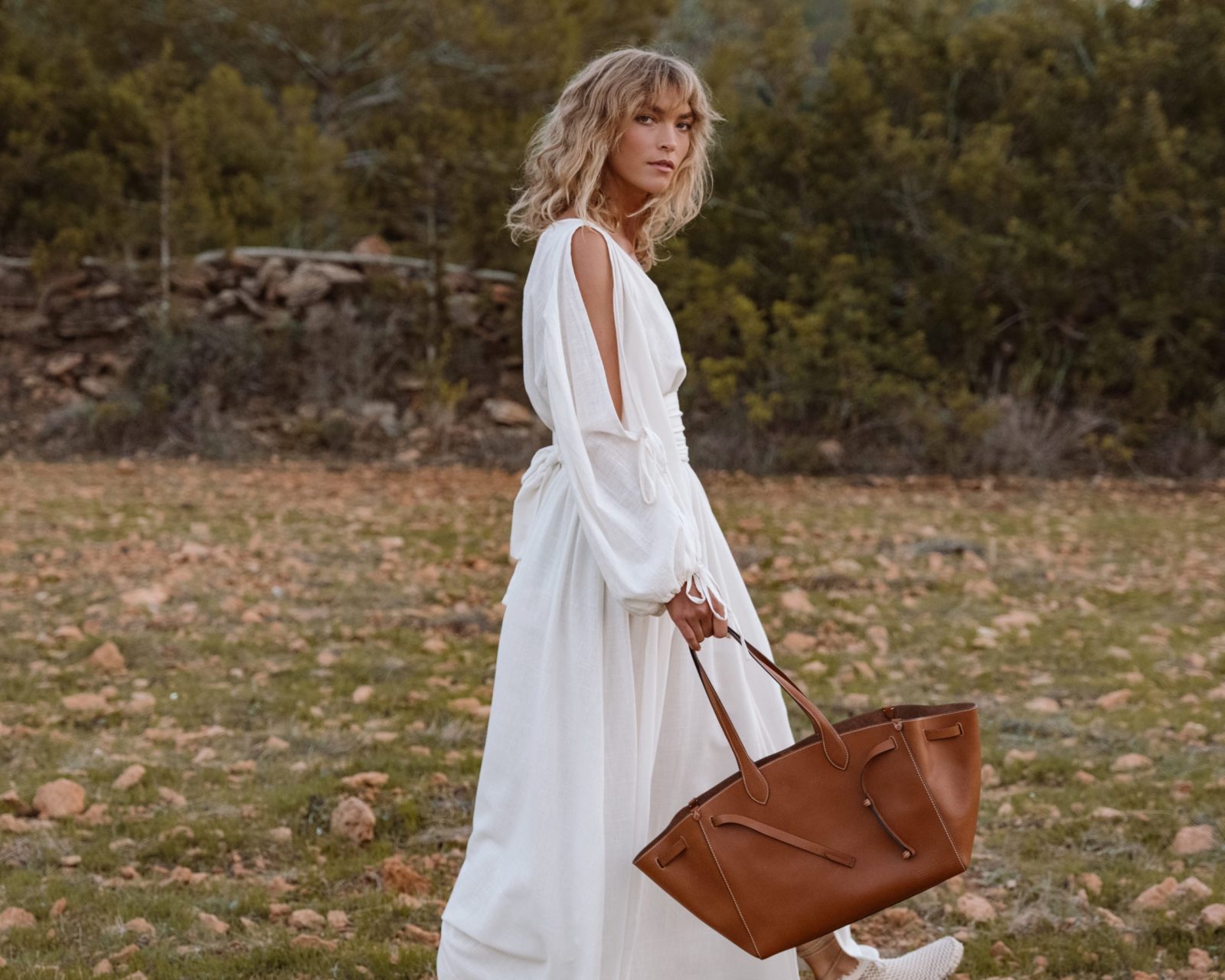
Arizona Muse carries the Return To Nature tote. Image in support of DIRT, the foundation for the regeneration of the earth
At this point, I should clarify that Hindmarch is really not expecting her customers to be chucking their luxe totes into the compost with the potato peelings any time soon. “Most of our buyers take their bags on a long life journey, going on eBay, passing them down and so on,” says Hindmarch, explaining how the project was both an “intellectual sort of challenge – could I make something that would never end up in landfill?”, but also a thought-starter for the whole industry: “If we could design into fashion practices that ensure nothing ends up in landfill, it would make a massive difference to our soil health and the soil’s ability to sequester carbon.”
“You know, truthfully, I am scared,” says Hindmarch, starkly, as she reflects on the climate emergency. “The situation is really quite terrifying, as frightening as anything we will ever experience.”
The landfill issue in particular is one that has haunted Hindmarch since working on her most recent upcycling project, ‘I Am A Plastic Bag’, in 2019. (Lest we forget, Hindmarch first made an impact in the single-use plastics supermarket debate with her ‘I Am Not A Plastic Bag’ initiative in 2007 – an initiative credited with reducing the use of virgin plastics by over 13,000 tonnes in just two years).
For all the plaudits she has received, and for all the progress she knows she has contributed to, there is a phrase used by recycling gurus that has stayed with her: “When you throw something away, there is no away,” she says. “We are spending all this energy and effort trying to stop sending stuff to landfill, but why don’t we stop the problem at source. You know, nature has no landfill.”
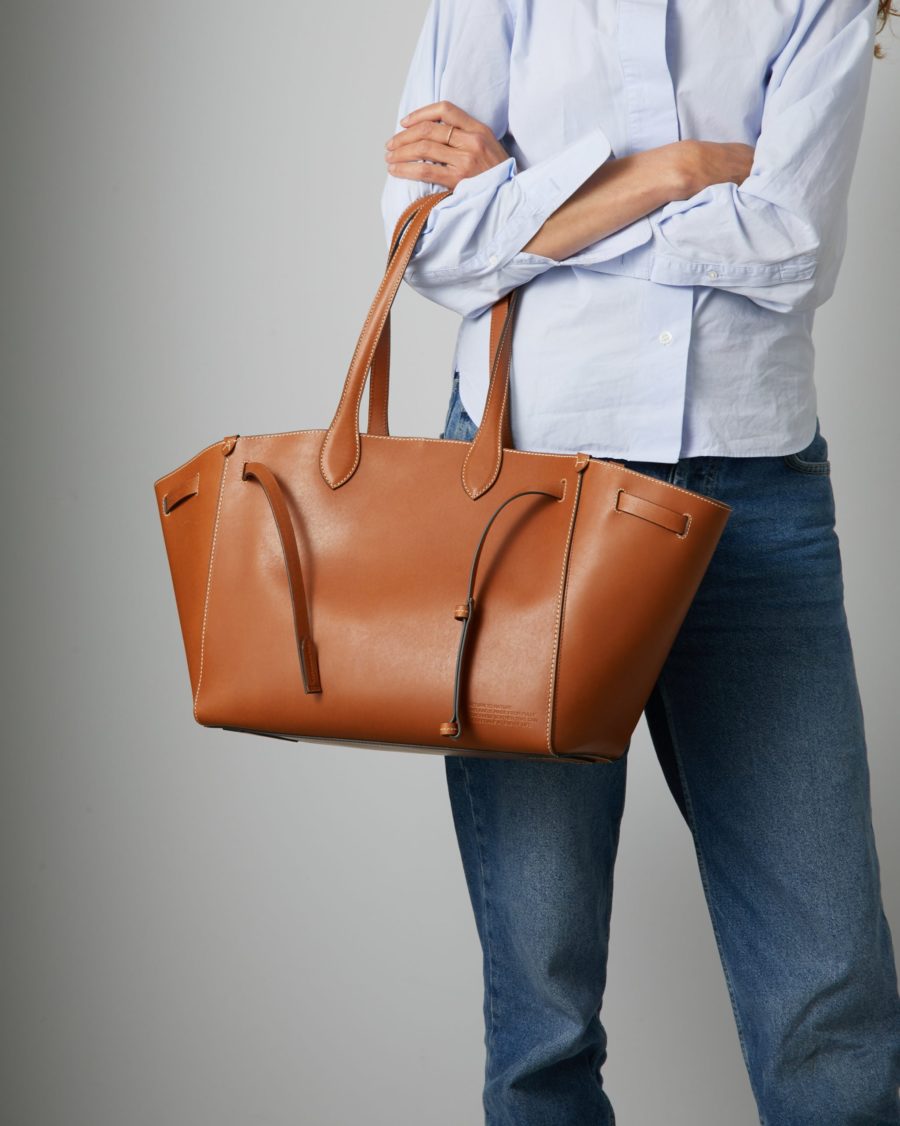
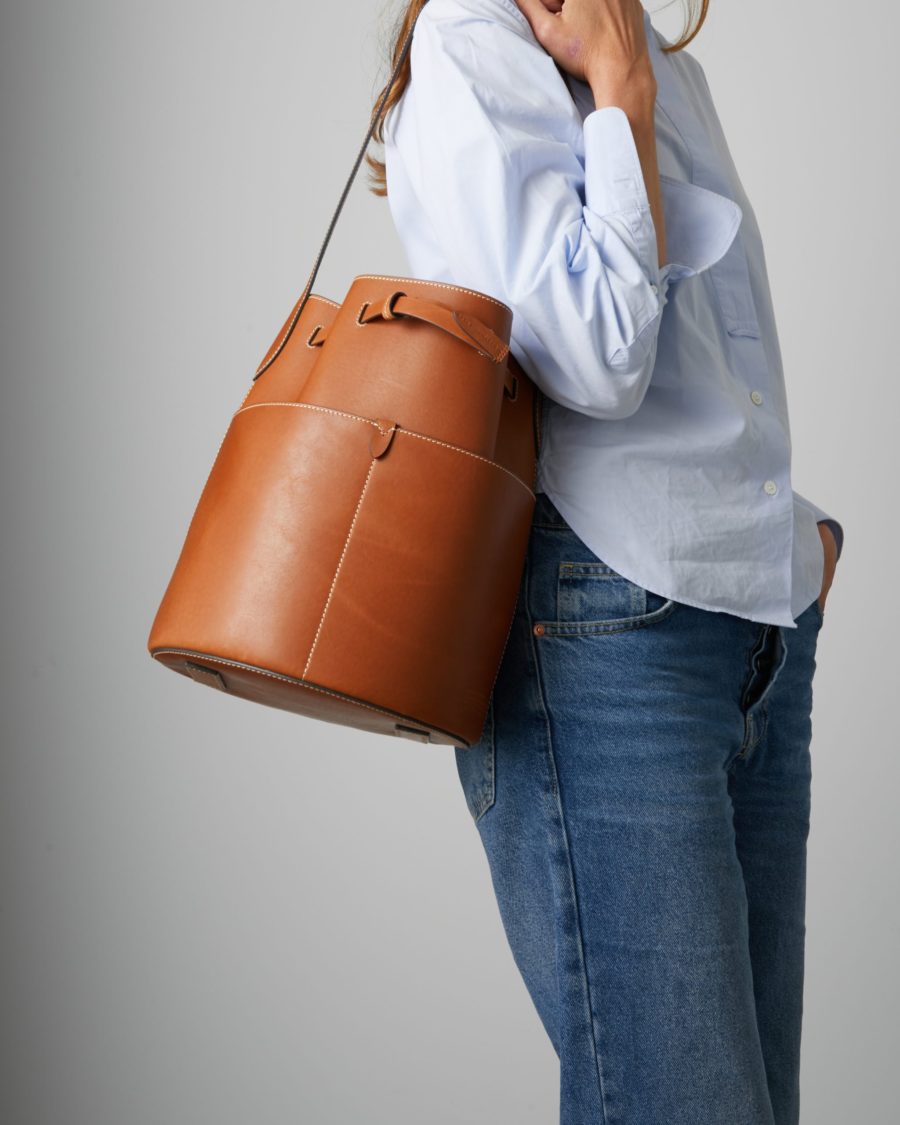
The Return To Nature tote and bucket bag styles crafted from leather that can biodegrade naturally
It was while wrestling with this conundrum that she happened to hear Muse speaking on the Wardrobe Crisis podcast about the idea of tanning a bag in such a way as to allow it to degrade naturally back into the earth after it had served its lifespan as an accessory. This was the decisive jolt to fire Hindmarch into action. (As a thank you, she is donating a sum, between £5 and £10, from the sale of each ‘Return To Nature’ bag to Muse’s foundation DIRT.)
Since that moment of epiphany, Hindmarch and her team have spent the past two years puzzling through every step in the design and production process, questioning industry norms and challenging a few shibboleths along the way. Not least was the decision to craft the bags from animal skins. Hindmarch explains that the more she dug into alternatives, the less convinced she became. “I thought about recycled leather, but in fact when I did my research, I found recycled leather is mixed in with plastic… And vegan leather, which is [usually] plastic, doesn’t decompose.” All said, she remains open to considering the possibilities of mushroom leather in the future, but for now, her assessment is that it doesn’t offer the look and feel her customer expects and desires.
Meticulous traceability of the skins was absolutely key to the project, and she chose Scan-Hide farms in Sweden, which offer the highest standards of animal welfare and transparency. To educate herself better about what constitutes a healthy sustainable farm – where a mix of crops and animals supports soil health – she drew on the knowledge of regenerative experts The Savory Global Institute, and in particular “an amazing woman called Sheila Cook”. It’s notable that Hindmarch does not guard this precious research like some jealous Gollum. In fact, quite the opposite is true. She wants to share her newly acquired knowhow with the industry, as she recognises that scale is the opportunity to truly effect change. “Arizona is really vocal about this as well,” she says.
“The fact is I am no expert,” the designer demurs. “Where I can add value is to approach this through the eyes of my customers, asking, ‘Well, hang on, what if, and why?’” For all her modesty, hearing Hindmarch talk through each of the process challenges she and her team have crunched through is nothing short of impressive. Take chrome tanning, which was introduced into the manufacture of leather in the 19th century and is one of the luxury industry’s dirty secrets (the chemicals used in the process leach into the ecosystem and can render soil unfit for food production). “I expect every one of your bags is chrome tanned,” says Hindmarch, at which I feel a chill of shame. Her solution was to use a new tanning technique called ‘zeology’, which uses naturally abundant clay and is heavy-metal free. Instead of PU coating (another standard and deeply planet-unfriendly industry finish), liquid silk was used, which allows the leather to biodegrade. And in lieu of hardware, she tasked artisans in Andalucia to develop ingenious leather fastenings to keep the bags secure. “You know, it’s funny, because you often add hardware to add value… But honestly, these [new fastenings] look so darn expensive because of this beautiful leather, you don’t need all that [hardware].”
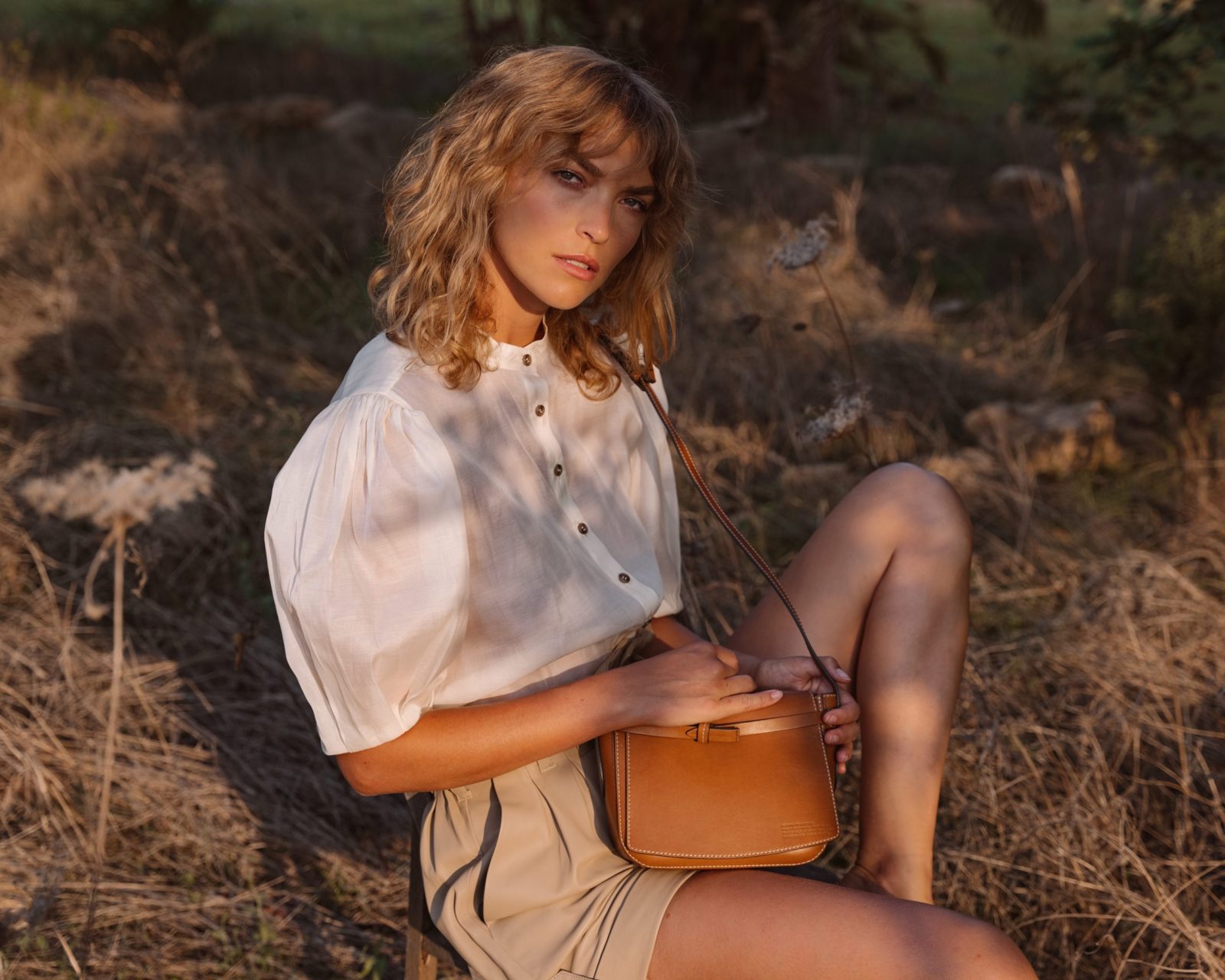
Muse models the cross-body style. Image in support of DIRT, the foundation for the regeneration of the earth
Of course, some challenges were knottier than others. There was a particularly troublesome “rain stops play” moment, when samples proved too porous to survive showers without spotting. In the end, a natural wax was sourced (developed by the family of a child who had severe allergies to household products). The eureka moment was the realisation that the bags would require continued waxing over time (each one comes with a little bottle of wax to keep it peachy and rain-resistant). “It’s a skin, like your own skin – people forget that you need to put moisturiser on it,” says Hindmarch, laughing. “Put on some barrier cream!”
This wit and lightness of touch is signature Hindmarch and it’s this quality, coupled with her gutsy, natural born entrepreneurial drive, that makes her such a potent and persuasive force. The daughter of an inventor, businessman father and a mother who taught French (the latter’s ’70s fashion sense has been a constant aesthetic inspiration), Hindmarch is possessed of a unique style and expansive vision that is at once utterly relatable and utterly singular. It is quite impossible to imagine any other designer deciding to put the world’s largest ‘Chubby Cloud’ bean bag in Whitehall during London Fashion Week (as she did in 2018) and then getting attendees to lie on it, chill awhile and think, by having them listen to the soothing tones of Radio 4’s The Shipping Forecast’. And who else could have ever designed an iconic evening clutch inspired by a humble crisp packet that really is like a little artwork – two parts Zaha Hadid sculpture to one part Walkers crisps?
"I think my happy place is fashion with a purpose."
Anya Hindmarch
As an indefatigable founder and figurehead of her brand for nearly 35 years in business, Hindmarch has been open about surfing the highs and lows of expansion, investment and shifting management structures. In 2019, she famously hosted a dinner of redoubtable women (guest of honour: Theresa May) at which she celebrated taking back the reins of her company as CEO, after a period with outside intestors had just come to an end. In the couple of years since, it has been thrilling to watch her innovative, game-changing spirit unleashed with full vigour – whether she’s creating biodegradable handbags, manufacturing and donating hospital uniform (as she did at the start of the pandemic), or breathing life into projects like the Anya Village in London’s Pont Street – a wonderfully whimsical and ever-evolving micro destination, where shoppers can experience such delights as Anya Cafe, The Labelled Shop (she is a self-declared organisation super-geek) and The Village Hall, which hosts pop-ups, collaborations and special projects.
Anya Village may not appear to be an obviously sustainability-focused endeavour, however the emphasis on hyper-localisation, rather than hyper-globalisation, is deliberate and rather radical. Just as the creation of a theatrical, bricks-and-mortar retail universe is an eye-catching case study demonstrating how a brand can operate according to their own timetable, rather than being at the mercy of the traditional fashion system with its ever-accelerating drops and discount model which inevitably drives over-supply. “I think I’ve found my happy place, actually. I mean, I’m crazy about creativity… It has a very important role in communication and making people happy and boosting economies and so forth,” she says. “But I think my happy place is fashion with a purpose. That’s even more exciting.”
Conversation segues to COP26: Hindmarch is not attending, but she has participated in several preparatory panels and she has three headline ideas for her industry. Firstly, she would like to see a mandated “sort of traffic-light system, a bit like with food, so you know whether something has been responsibly sourced”. Secondly, while she is “nervous of suggesting a carbon tax”, she believes the threat of it “would make people get their supply chains in order”. Thirdly, she would like better regulations around carbon off-setting schemes: “There are an awful lot of charlatan offsetters out there; you should at least be putting your money into something that you trust.”
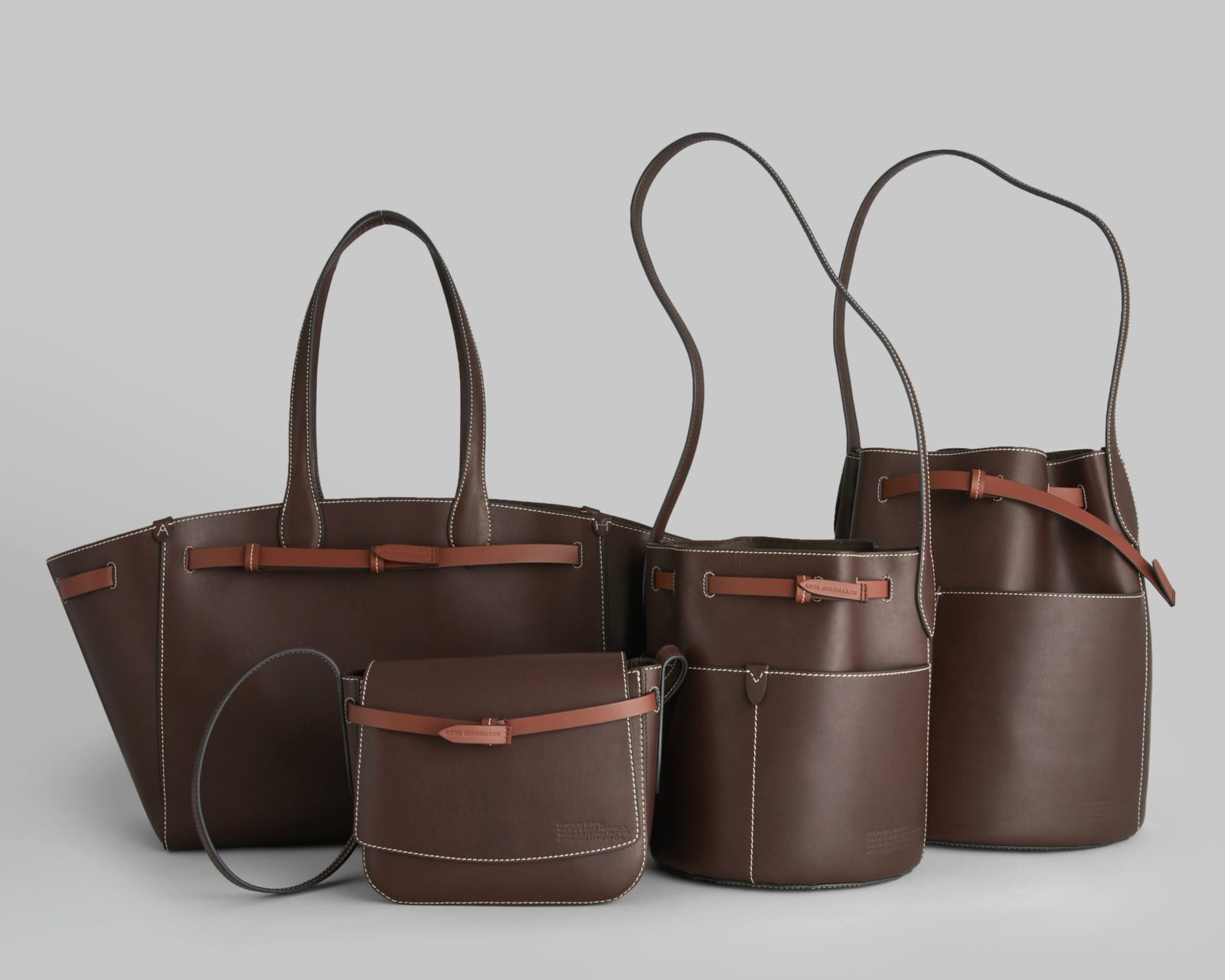
The Return To Nature collection is also available in a rich chocolate hue
Away from the policy-making table, she is pragmatic and realistic about driving change and is wary of the gospel of perfectionism, which can too easily dishearten and overwhelm an organisation. Of her own company, she readily admits: “We’re not perfect. I think it’s very important to say that loudly, to make sure that everyone can chip off bits, all the time. It’s those tiny increments that make big strides.”
Fundamentally, she wants to help fuel a cultural and mindset shift so that sustainability and traceability in fashion is no longer the preserve of enlightened converts, but a mainstream consumer demand, just as we have witnessed in the food sector. “Remember, when we were growing up, it was Angel Delight and fish fingers and we had no idea what was in them. Now it’s a case of, ‘I bought it from the farm shop’. Everyone is aware of the provenance of their food.” Ah, farming again.
Our Zoom call together is nearly up and the weekend will soon be upon us. Downtime for Hindmarch these days is mostly spent at her country escape in Wiltshire, where the agricultural land that surrounds her and the farmers, who are both neighbours and friends, continues to fuel her thinking about the ecological balance that underpins everything: cows, food, business… On that note, she’s keen to know if I’ve seen Clarkson’s Farm – Jeremy Clarkson’s TV show about his own farm Diddly Squat. “Honestly, it is the funniest thing ever, but you know he has actually opened up the conversation about how difficult farming is and how incredibly important it is,” she says with a smile. “Watch it, you will love it.”
This is pure Anya, of course – unexpected, unpretentious and profoundly wise. All hail this charming purveyor of luxury goods with transformative power and purpose, changing the world and what we desire, one handbag at a time.
The ‘Return To Nature’ collection is available from www.anyahindmarch.com and www.matchesfashion.com with prices starting at £650. For each bag sold globally, a donation will be made (from £5-£10) to DIRT, the foundation for the regeneration of the earth

